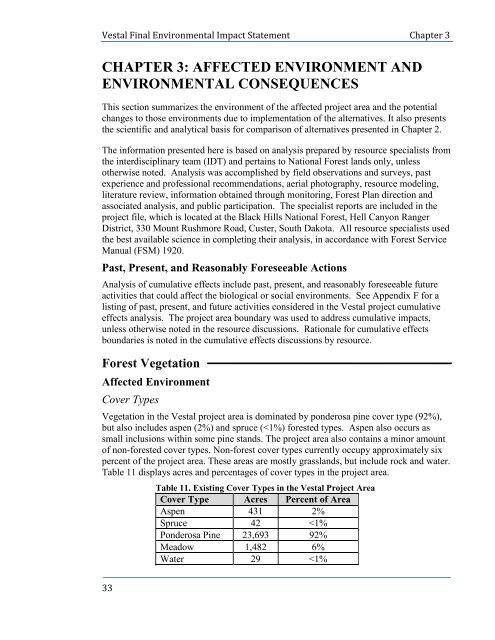Final Environmental Impact Statement
Final Environmental Impact Statement
Final Environmental Impact Statement
Create successful ePaper yourself
Turn your PDF publications into a flip-book with our unique Google optimized e-Paper software.
Vestal <strong>Final</strong> <strong>Environmental</strong> <strong>Impact</strong> <strong>Statement</strong> Chapter 3<br />
CHAPTER 3: AFFECTED ENVIRONMENT AND<br />
ENVIRONMENTAL CONSEQUENCES<br />
This section summarizes the environment of the affected project area and the potential<br />
changes to those environments due to implementation of the alternatives. It also presents<br />
the scientific and analytical basis for comparison of alternatives presented in Chapter 2.<br />
The information presented here is based on analysis prepared by resource specialists from<br />
the interdisciplinary team (IDT) and pertains to National Forest lands only, unless<br />
otherwise noted. Analysis was accomplished by field observations and surveys, past<br />
experience and professional recommendations, aerial photography, resource modeling,<br />
literature review, information obtained through monitoring, Forest Plan direction and<br />
associated analysis, and public participation. The specialist reports are included in the<br />
project file, which is located at the Black Hills National Forest, Hell Canyon Ranger<br />
District, 330 Mount Rushmore Road, Custer, South Dakota. All resource specialists used<br />
the best available science in completing their analysis, in accordance with Forest Service<br />
Manual (FSM) 1920.<br />
Past, Present, and Reasonably Foreseeable Actions<br />
Analysis of cumulative effects include past, present, and reasonably foreseeable future<br />
activities that could affect the biological or social environments. See Appendix F for a<br />
listing of past, present, and future activities considered in the Vestal project cumulative<br />
effects analysis. The project area boundary was used to address cumulative impacts,<br />
unless otherwise noted in the resource discussions. Rationale for cumulative effects<br />
boundaries is noted in the cumulative effects discussions by resource.<br />
Forest Vegetation<br />
Affected Environment<br />
Cover Types<br />
Vegetation in the Vestal project area is dominated by ponderosa pine cover type (92%),<br />
but also includes aspen (2%) and spruce (

















